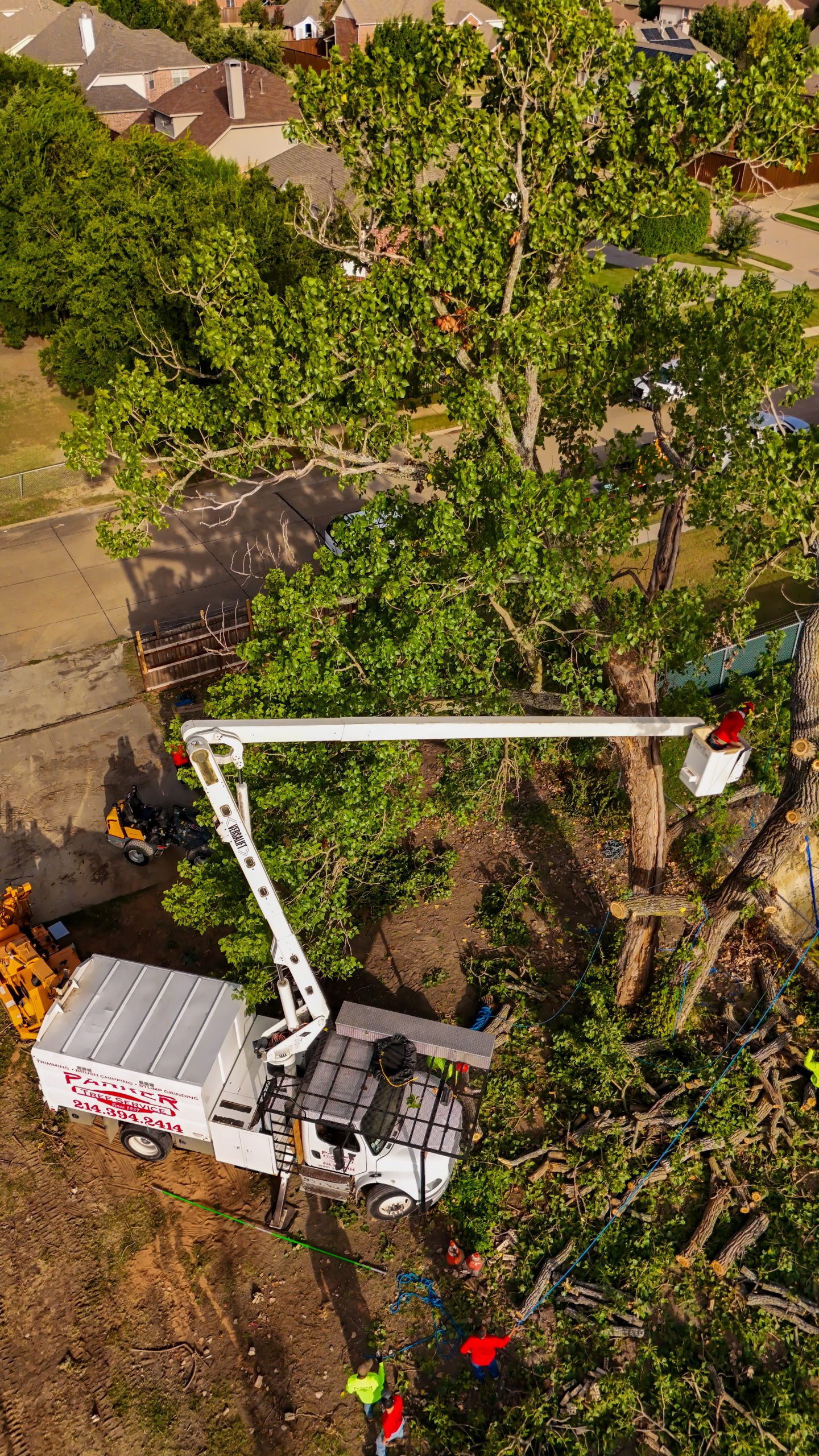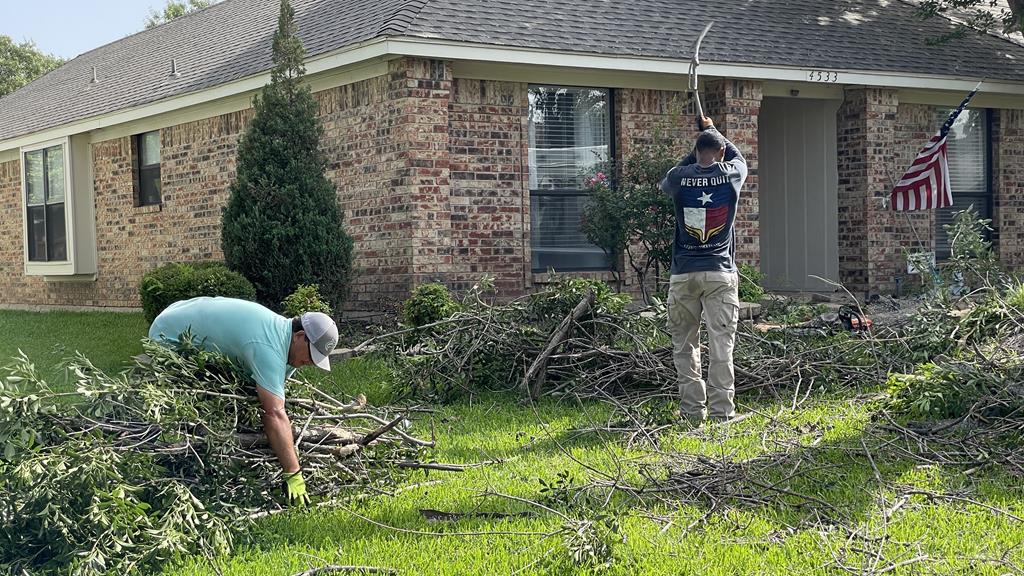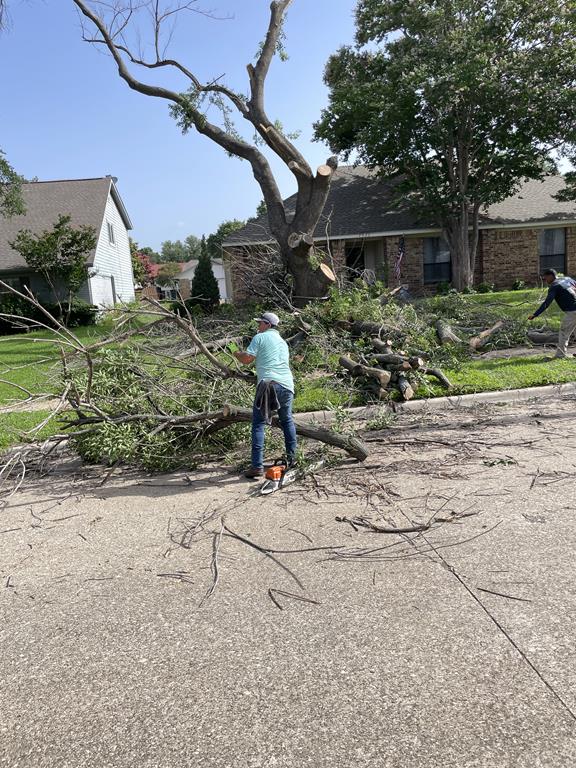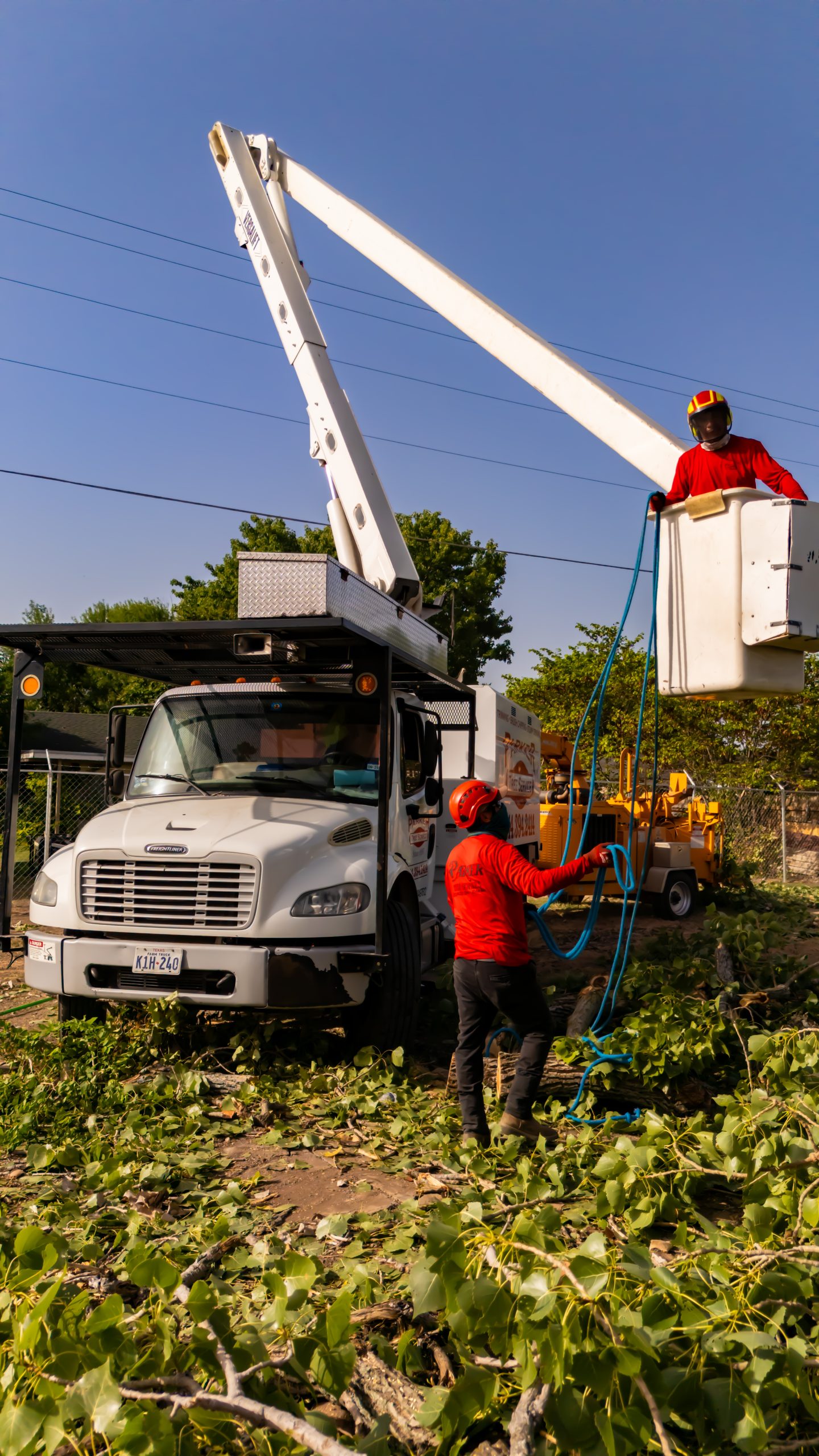Tree Pruning, Trimming, Reduction
Tree Trimming, Tree Removal, and Stump Removal
For Plano, Dallas and DFW Suburbs
Tree Pruning and Tree Trimming
Expert Tree Care for a Thriving Landscape
We handle residential and commercial tree pruning and trimming, from large oak trees to smaller ornamentals (apple, cherry, etc.). Fine-pruning trees in your landscape takes skill, and it’s as much of an art…
… as a science. Some companies shortcut the job and compromise the tree’s future, removing critical, nourishing branches.
Trimming and thinning is an important and often-overlooked necessity in landscape maintenance. Thinning removes unwanted excess branch growth, deadwood, and debris – removing a favored breeding ground for boring beetles and insects that damage and kill trees.
Pruning back overgrowth lightens the load on over-burdened branches and reduces windsail, greatly improving the tree’s safety risk, while leaving valuable shade. Pruning and thinning tree maintenance prolongs a tree’s lifespan too, since we’re shaping the tree in ways that allow new and future growth to occur in the right places and in proper directions, improving the capacity for greater natural growth.
Periodic tree maintenance via pruning, trimming, and thinning is important for appearance and safety because it helps sculpt or train the tree, forcing it to grow how we want it to. Left to its own, a tree will often grow in strange and unmanageable directions. As the un-managed and overweight tree grows larger and heavier each year, it can actually kill itself by essentially splitting in half (often in a heavy wind), destroying the cambium and its ability to grow. Even if the tree survives, the exposed and ripped-apart areas where the breaks occur are an open invitation for insect infestation (then a slower, painful-to-watch death takes place).
Encouraging Growth and Preventing Disease
Strategically and selectively removing specific branches, carefully shaping the tree, is sometimes called fine pruning. Anyone can chop branches off a tree, but we regard fine pruning as art form, because we are carefully forming an aesthetically perfect tree (and thus allowing future growth to occur correctly and naturally). Some inexperienced companies are more haphazard and take a very short time, presumably because they just don’t understand or care about the “art” (or perhaps to low-ball their bid), but you definitely will get what you pay for.
Reducing the size – height or width – of a tree and/or its canopy is known as Reduction. The wrong way is “pollarding” (topping) a tree, which was common in the past but is acknowledged today by tree experts and arborists as a very bad tree maintenance practice. Abruptly lopping off the top/s of a tree’s crown/s causes deformation and what grows up are groups of “finger branches” that trap leaves and debris, which fosters rot (included bark) and insect infestation, as well as dangerous windsail. Reducing a tree the right way involves cutting multi-pronged branches back to their main laterals and, again, the strategic removal of specifically selected branches. The appearance of the tree becomes centered and balanced and also improves the tree’s safety risk.
Parker Tree Service has specialized in tree pruning, thinning, trimming, and reduction since 1937. Let us show you why.


Contact Us Today!
A member of our team will be in touch shortly.

Trustindex verifies that the original source of the review is Google. Just had the crew out to the house for a 50-foot tree removal and to have 2 trees trimmed. They were fast and cleaned up like nothing was done at all. I would recommend them to my family and friendsTrustindex verifies that the original source of the review is Google. I highly recommend Parker Tree Service! They were prompt, efficient and knowledgeable. The jobsite was clean when they finished. Very reasonably priced!Trustindex verifies that the original source of the review is Google. I’ve been using Parker for 3 years now. The most professional / honest service out there. Upon initial consultation, Ryder explained exactly what would be done and even explained the growth habits of my pecan tree. Irving and his crew were professional and courteous and answered all my questions. The job was done quickly and as far as cleanup you’d never know they were here. I highly recommend Parker Tree Service!!Trustindex verifies that the original source of the review is Google. Recently worked with Parker Tree service after the May storm took out trees and one landed on my house. George was out the same day to assess the work and a couple of days later had his crew removing and cutting up the trees in several inches of mud. His crew is awesome, didn't leave even a leaf laying around. Came back later to grind stumps and backyard looks better than ever! He is very knowledgeable about all the trees and their health and is passionate about it. If you want healthy trees that are properly trimmed and taken care of, hire Parker Tree Service! I will be using them for all of my future tree care needs.Trustindex verifies that the original source of the review is Google. This is 3rd time to use Parker Tree Service at my mom’s house. She is 86 and I’m. So appreciative how respectful the team is to her. They do a great job and totally clean when they leave. Reasonable pricing for the work.Trustindex verifies that the original source of the review is Google. I have used Parker Tree Services to remove one of the tree. I definitely recommend them. It was a hassle free from getting the quote to getting the work done. Very professional team they came on time and cleaned up very well.Trustindex verifies that the original source of the review is Google. The storm in May left a chaotic mess on my house. Tree limbs blocked me from pulling out of my driveway. I had one tree split in half and another tree that was badly damaged . I have used Parker Tree Service in the past and called them right away. George and Ryder are the best. They came out immediately and got to work. They have a team of experienced professionals that go above and beyond to do a great job. George went toe to toe with my insurance company and saved me so much money. They are very fair on their pricing. They are the best and I will only use there company in the future. Thank you Parker Tree Service. Amy NicelyTrustindex verifies that the original source of the review is Google. George and his crew have always done excellent work for me with very competitive prices and a very professional crew!Trustindex verifies that the original source of the review is Google. I have used Parker Trees Service 5 times in 10 year's. Very time they have been really nice ,on time and did a really great job every time that I have used them. They cleaned up after that did Very job. What they charge to the jobs is really good. What I like about them that they cut down the trees and takes away all of tree branches and clean up after they are done. RoyTrustindex verifies that the original source of the review is Google. Ryder (or Ryan?) came out for the free consultation and he was thoroughly impressive. He is well mannered and professional and has a wealth of knowledge and passion about trees. He offered many insights and advices about trees, and even gave helpful tips about landscaping. Despite I eventually went with the other tree service company due to their existing relationship with the landscaper I had hired, I completely understand the high ratings and many stellar reviews Parker Tree services receives. If I were to base my decision solely on the sales representative I would have absolutely gone with Parker Tree Service. They're evidently a great company with outstanding services.
Expert Tree Pruning, Trimming, and Reduction in Dallas-Fort Worth
Your Trusted Tree Care Specialists
Parker Tree Service is committed to providing professional pruning, trimming, and tree reduction services throughout Dallas-Fort Worth. Whether you need to enhance tree health, remove hazardous limbs, or maintain a well-groomed landscape, our skilled arborists are here to help.
With years of experience, advanced techniques, and a dedication to customer satisfaction, we ensure that your trees receive the best care possible. Contact Parker Tree Service today for a free consultation and let us help you maintain a beautiful, safe, and thriving landscape.
Trustindex verifies that the original source of the review is Google. Just had the crew out to the house for a 50-foot tree removal and to have 2 trees trimmed. They were fast and cleaned up like nothing was done at all. I would recommend them to my family and friendsTrustindex verifies that the original source of the review is Google. I highly recommend Parker Tree Service! They were prompt, efficient and knowledgeable. The jobsite was clean when they finished. Very reasonably priced!Trustindex verifies that the original source of the review is Google. I’ve been using Parker for 3 years now. The most professional / honest service out there. Upon initial consultation, Ryder explained exactly what would be done and even explained the growth habits of my pecan tree. Irving and his crew were professional and courteous and answered all my questions. The job was done quickly and as far as cleanup you’d never know they were here. I highly recommend Parker Tree Service!!Trustindex verifies that the original source of the review is Google. Recently worked with Parker Tree service after the May storm took out trees and one landed on my house. George was out the same day to assess the work and a couple of days later had his crew removing and cutting up the trees in several inches of mud. His crew is awesome, didn't leave even a leaf laying around. Came back later to grind stumps and backyard looks better than ever! He is very knowledgeable about all the trees and their health and is passionate about it. If you want healthy trees that are properly trimmed and taken care of, hire Parker Tree Service! I will be using them for all of my future tree care needs.Trustindex verifies that the original source of the review is Google. This is 3rd time to use Parker Tree Service at my mom’s house. She is 86 and I’m. So appreciative how respectful the team is to her. They do a great job and totally clean when they leave. Reasonable pricing for the work.Trustindex verifies that the original source of the review is Google. I have used Parker Tree Services to remove one of the tree. I definitely recommend them. It was a hassle free from getting the quote to getting the work done. Very professional team they came on time and cleaned up very well.Trustindex verifies that the original source of the review is Google. The storm in May left a chaotic mess on my house. Tree limbs blocked me from pulling out of my driveway. I had one tree split in half and another tree that was badly damaged . I have used Parker Tree Service in the past and called them right away. George and Ryder are the best. They came out immediately and got to work. They have a team of experienced professionals that go above and beyond to do a great job. George went toe to toe with my insurance company and saved me so much money. They are very fair on their pricing. They are the best and I will only use there company in the future. Thank you Parker Tree Service. Amy NicelyTrustindex verifies that the original source of the review is Google. George and his crew have always done excellent work for me with very competitive prices and a very professional crew!Trustindex verifies that the original source of the review is Google. I have used Parker Trees Service 5 times in 10 year's. Very time they have been really nice ,on time and did a really great job every time that I have used them. They cleaned up after that did Very job. What they charge to the jobs is really good. What I like about them that they cut down the trees and takes away all of tree branches and clean up after they are done. RoyTrustindex verifies that the original source of the review is Google. Ryder (or Ryan?) came out for the free consultation and he was thoroughly impressive. He is well mannered and professional and has a wealth of knowledge and passion about trees. He offered many insights and advices about trees, and even gave helpful tips about landscaping. Despite I eventually went with the other tree service company due to their existing relationship with the landscaper I had hired, I completely understand the high ratings and many stellar reviews Parker Tree services receives. If I were to base my decision solely on the sales representative I would have absolutely gone with Parker Tree Service. They're evidently a great company with outstanding services.
Our Services


